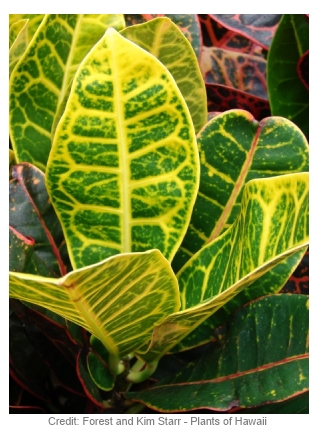






Grown in it's natural habitat and outdoors this evergreen shrub can grow up to 3 metres tall, so in gardens they look great planted around borders like bushes or hedges. Indoors if your able to provide the correct temperatures and humidity levels they're an interesting container plant that adds a touch of color to a room. The room will need to be bright and have sunlight, though.
How it looks: As mentioned - the variegated croton is primarily grown for it's foliage and not the flowers (because they are not attractive and insignificant enough). The leathery type leaves can vary in color and size depending on which variety it is, however, a grower is guaranteed interesting colors appearing - which turn from green to a deep purple quite often. These leaves display prominent veins.
Flowering: The flowers bloom in white and yellow small clusters along a stem at various times of the year in it's natural habitat, but they're less likely to flower indoors.
Displaying: The croton is grown quite often inside a greenhouse or conservatory, because of it's need for bright light and it's size. It can also grow anywhere in your home if you provide the correct conditions, such as plenty of water, placed near an east or west facing windowsill, a place to grow without cold drafts and high humidity levels.
Poisonous: The milky sap on this plant is toxic. If children, dogs or cats ingest parts of this plant various symptoms can be caused - including, nausea, vomiting, and diarrhoea. The sap can also cause skin irritation, so when handling the plant it's advisable to wear gloves.

Leaves losing color: Most common cause is not enough light which is probably the biggest problem for croton owners.
Brown leaf tips or edges: The air is possibly too dry or the soil is dry if the tips are turning brown and your losing some of the lower leaves. If the edges are turning brown the temperature might be too low.
Insects: Mealy bugs and scale are known to cause croton plants a problem.
Copyright © www.100flowers.win Botanic Garden All Rights Reserved